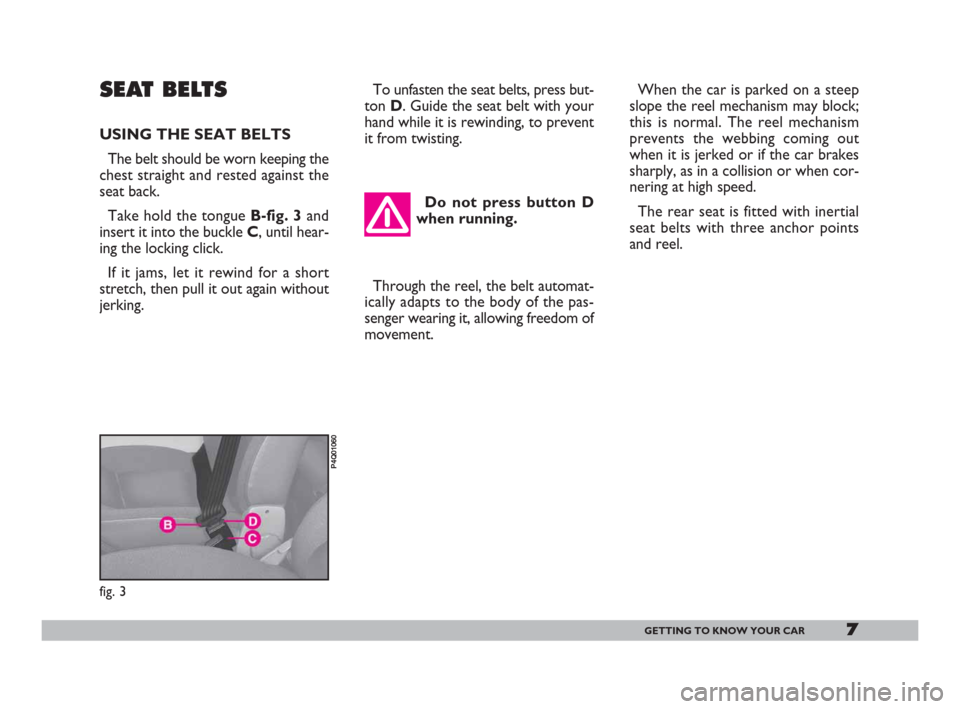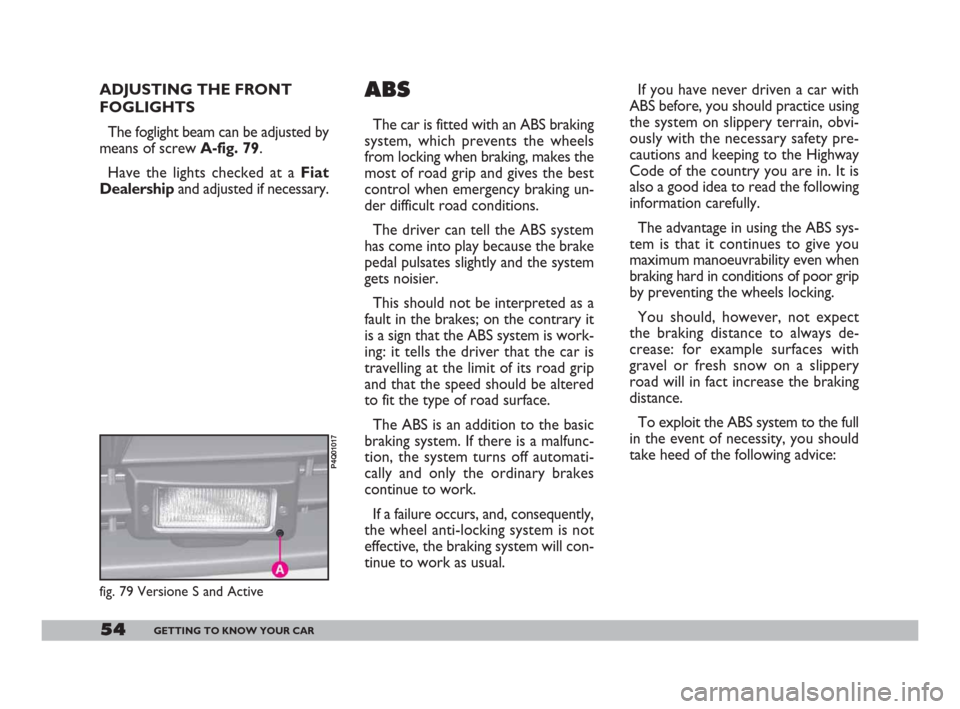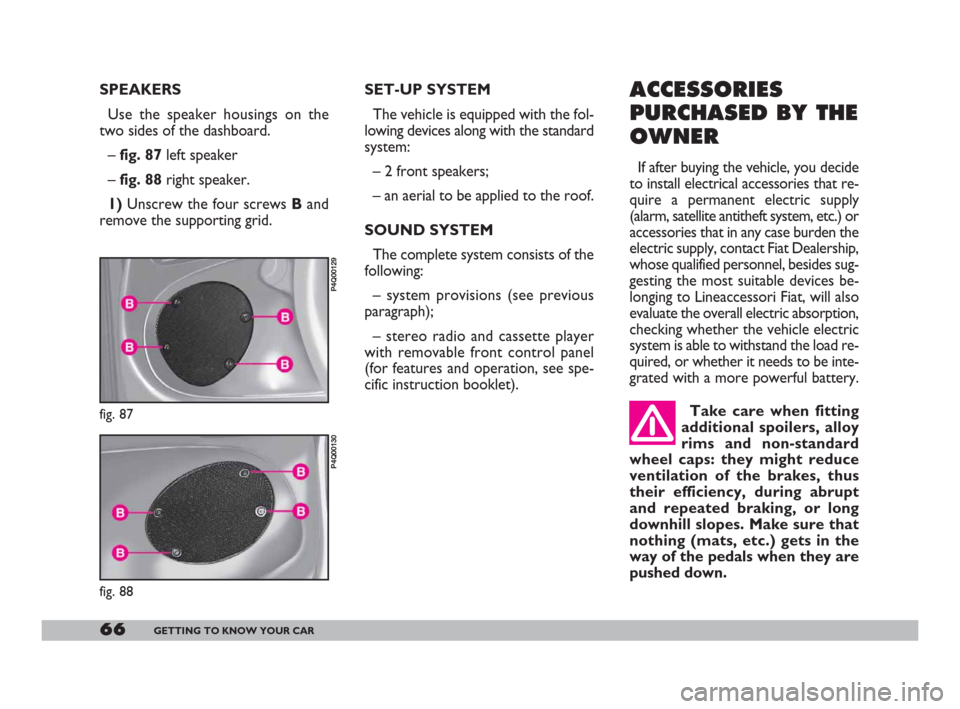2007 FIAT 600 brakes
[x] Cancel search: brakesPage 8 of 146

7GETTING TO KNOW YOUR CAR
When the car is parked on a steep
slope the reel mechanism may block;
this is normal. The reel mechanism
prevents the webbing coming out
when it is jerked or if the car brakes
sharply, as in a collision or when cor-
nering at high speed.
The rear seat is fitted with inertial
seat belts with three anchor points
and reel. To unfasten the seat belts, press but-
ton D. Guide the seat belt with your
hand while it is rewinding, to prevent
it from twisting.SEAT BELTS
USING THE SEAT BELTS
The belt should be worn keeping the
chest straight and rested against the
seat back.
Take hold the tongue B-fig. 3and
insert it into the buckle C, until hear-
ing the locking click.
If it jams, let it rewind for a short
stretch, then pull it out again without
jerking.
fig. 3
P4Q01060
Do not press button D
when running.
Through the reel, the belt automat-
ically adapts to the body of the pas-
senger wearing it, allowing freedom of
movement.
001-069 Seicento GB 22-11-2007 10:49 Pagina 7
Page 55 of 146

54GETTING TO KNOW YOUR CAR
ADJUSTING THE FRONT
FOGLIGHTS
The foglight beam can be adjusted by
means of screw A-fig. 79.
Have the lights checked at a Fiat
Dealershipand adjusted if necessary. If you have never driven a car with
ABS before, you should practice using
the system on slippery terrain, obvi-
ously with the necessary safety pre-
cautions and keeping to the Highway
Code of the country you are in. It is
also a good idea to read the following
information carefully.
The advantage in using the ABS sys-
tem is that it continues to give you
maximum manoeuvrability even when
braking hard in conditions of poor grip
by preventing the wheels locking.
You should, however, not expect
the braking distance to always de-
crease: for example surfaces with
gravel or fresh snow on a slippery
road will in fact increase the braking
distance.
To exploit the ABS system to the full
in the event of necessity, you should
take heed of the following advice:ABS
The car is fitted with an ABS braking
system, which prevents the wheels
from locking when braking, makes the
most of road grip and gives the best
control when emergency braking un-
der difficult road conditions.
The driver can tell the ABS system
has come into play because the brake
pedal pulsates slightly and the system
gets noisier.
This should not be interpreted as a
fault in the brakes; on the contrary it
is a sign that the ABS system is work-
ing: it tells the driver that the car is
travelling at the limit of its road grip
and that the speed should be altered
to fit the type of road surface.
The ABS is an addition to the basic
braking system. If there is a malfunc-
tion, the system turns off automati-
cally and only the ordinary brakes
continue to work.
If a failure occurs, and, consequently,
the wheel anti-locking system is not
effective, the braking system will con-
tinue to work as usual.
fig. 79 Versione S and Active
P4Q01017
001-069 Seicento GB 22-11-2007 10:49 Pagina 54
Page 67 of 146

66GETTING TO KNOW YOUR CAR
SPEAKERS
Use the speaker housings on the
two sides of the dashboard.
– fig. 87 left speaker
– fig. 88 right speaker.
1)Unscrew the four screws Band
remove the supporting grid. SET-UP SYSTEM
The vehicle is equipped with the fol-
lowing devices along with the standard
system:
– 2 front speakers;
– an aerial to be applied to the roof.
SOUND SYSTEM
The complete system consists of the
following:
– system provisions (see previous
paragraph);
– stereo radio and cassette player
with removable front control panel
(for features and operation, see spe-
cific instruction booklet).
fig. 88
P4Q00130
fig. 87
P4Q00129
ACCESSORIES
PURCHASED BY THE
OWNER
If after buying the vehicle, you decide
to install electrical accessories that re-
quire a permanent electric supply
(alarm, satellite antitheft system, etc.) or
accessories that in any case burden the
electric supply, contact Fiat Dealership,
whose qualified personnel, besides sug-
gesting the most suitable devices be-
longing to Lineaccessori Fiat, will also
evaluate the overall electric absorption,
checking whether the vehicle electric
system is able to withstand the load re-
quired, or whether it needs to be inte-
grated with a more powerful battery.
Take care when fitting
additional spoilers, alloy
rims and non-standard
wheel caps: they might reduce
ventilation of the brakes, thus
their efficiency, during abrupt
and repeated braking, or long
downhill slopes. Make sure that
nothing (mats, etc.) gets in the
way of the pedals when they are
pushed down.
001-069 Seicento GB 22-11-2007 10:50 Pagina 66
Page 72 of 146

71DRIVING YOUR CAR
EMERGENCY START-UP
If the Fiat CODE system fails to
recognise that code transmitted by
the ignition key (instrument panel
warning light ¢on) the emergency
start-up can be performed by using
the CODE card code.
See the
IN AN EMERGENCY. A quick burst on the ac-
celerator before turning
off the engine serves ab-
solutely no practical purpose and
wastes fuel.
IMPORTANTAfter a taxing drive
it is better to allow the engine to
“catch its breath” before turning it off,
by letting it idle to allow the temper-
ature in the engine compartment to
fall.
PARKING
Switch off the engine, pull up the
handbrake and put the car in 1st gear
if the car is pointing uphill, reverse if
downhill.
If the car is parked on a steep gradi-
ent it is a good idea to use a stone or
wedge to block the wheels.
Do not leave the ignition key at
MARbecause it drains the battery.
Always remove the key when you
leave the car. Bump starting by push-
ing, towing or rolling
downhill must be avoided
at all costs. This way of starting
could cause a rush of fuel into the
catalytic exhaust pipe and dam-
age it beyond repair.
Remember that as long
as the engine is not run-
ning, the power brakes
and power steering do not work.
You therefore have to use con-
siderably more effort on both the
brake pedal and the steering
wheel. SWITCHING OFF
THE ENGINE
Turn the key to STOPwhile the
engine is idling.
Never leave unsuper-
vised children in the car.
070-082 Seicento GB 22-11-2007 10:50 Pagina 71
Page 104 of 146

103IN AN EMERGENCY
Before starting to tow,
turn the ignition key to
MAR and then to STOP.
Do not remove the key. If the
key is removed, the steering lock
engages automatically which pre-
vents the wheels being turned.
While the car is being
towed with the engine
off, remember that the
brake pedal and steering will re-
quire more effort as you no
longer have the benefit of the
power brakes and power steer-
ing. Do not use flexible cables to
tow. Avoid jerking. Whilst tow-
ing, ensure that the coupling to
the vehicle does not damage the
surrounding components.
The car can be lifted
from the side providing
the hydraulic jack arm is
fitted with a special bracket in
the plate housing.
WITH AN ARM HOIST
Jack up the car by arranging the ends
of the arms in the areas shown in
fig. 45.
IF THE CAR NEEDS
TO BE TOWED
A tow hitch is provided with the car.
To fasten the tow hitch:
1)Take the tow eye from the spare
wheel in the boot.
When towing the car,
you must comply with
the specific traffic regula-
tions regarding the tow hitch and
how to tow on the road.
fig. 45
P4Q00138
From the side
083-104 Seicento GB 22-11-2007 10:50 Pagina 103
Page 108 of 146

107CAR MAINTENANCE
thousands of kilometres
Check anti-evaporation system
Replace air cleaner cartridge
Top up fluids (engine coolant, brakes, windscreen washer, battery, etc.)
Check timing belt conditions
Replace timing belt (*)
Replace spark plugs
Check engine control systems via diagnostic socket
Check mechanical gearbox oil level
Change engine oil
Replace engine oil filter
Change brake fluid (or every two years) 20 40 60 80 100 120 140 160 180
●●
●●●●
●●●●●●●●●
●●
●
●●●●
●●●●
●●
●●●●●●●●●
●●●●●●●●●
●●●
(*) or every 3 years for demanding use (cold climates, prolonged idling in city traffic)
or every 5 years, regardless of distance
105-123 Seicento GB 22-11-2007 10:51 Pagina 107
Page 109 of 146

108CAR MAINTENANCE
ANNUAL INSPECTION SCHEDULE
– Inspect conditions of. engine, gear-
box, transmission, piping (exhaust -
fuel feed - brakes), rubber parts
(boots - sleeves - bushings - etc.),
brake and fuel line hoses.
– Check for bonnet and boot lock
cleanness, lever cleanness and lubri-
cation.
– Check battery charge status.
– Check conditions of various con-
trol belts.
– Check and top up fluid levels (en-
gine coolant, brakes, windscreen
washer, battery, etc.).
– Change engine oil.
– Replace engine oil filter.
– Replace pollen filter (where fitted). The following annual inspection
schedule is recommended for
cars travelling less than
20,000 km a year (e.g. approxi-
mately 10,000 km). The schedule
includes the following operations:
– Check tyre condition and wear
and adjust pressure, if required (in-
cluding spare wheel).
– Check operation of lights (head-
lights, direction indicators, hazard
lights, boot light, passenger compart-
ment ceiling light, glove compartment
light, instrument panel lights, etc.).
– Check windscreen wiper/washer
and adjust nozzles.
– Check position wear of wind-
screen/rear window wiper blades.
– Check front brake pad conditions
and wear.
ADDITIONAL
CHECKS
Every 1,000 kmor before long
trips, check and top up as necessary:
– engine coolant level, brake fluid
level, windscreen washer liquid level,
tyre pressure and conditions.
Every 3,000 kmcheck and top up
as necessary: engine oil level.
We recommend using FL Selenia
products which were specifically de-
signed and made for use in Fiat vehi-
cles (see
CAPACITIEStable in TECHNICAL
SPECIFICATIONS
).
105-123 Seicento GB 22-11-2007 10:51 Pagina 108
Page 128 of 146

127TECHNICAL SPECIFICATIONS
BRAKES
SERVICE AND EMERGENCY
BRAKES
Front:
– disc, floating caliper type with op-
erating cylinder for each wheel.
Rear:
– drum type with self-centring shoes
and operating cylinder for each wheel.
Crossed hydraulic circuit control.
7” vacuum brake booster.
ABS system with four sensors
(where fitted).
Automatic take-up of friction liner
wear.
Brake effort proportioning valves (2)
intervening on hydraulic circuit of the
rear brakes. HANDBRAKE
Controlled by a lever, it works me-
chanically on the rear brakes.
SUSPENSION
Front:
Independent wheel type, lower wish-
bones anchored to telescopic sup-
ports consisting of a cast iron riser
rigidly connected to a hydraulic dou-
ble action shock absorber. Leaf spring
and coaxial pads with the shock ab-
sorbers. Permanently lubricated joints.
Anti-roll bar anchored to the body
acting on suspension arm.
Rear:
Independent wheel with coil springs.
Jointed steel arms with bush and dou-
ble action telescopic gas shock ab-
sorbers. Water, ice and salt
sprinkled on the road de-
posit on the brake disc
and reduce effectiveness when
you brake.
Pay attention when in-
stalling extra spoilers, al-
loy wheels and non stan-
dard wheel caps: they could re-
duce the ventilation of the
brakes, thus reducing their effi-
ciency when braking suddenly
and frequently, or on long down-
hill slopes.
124-136 Seicento GB 22-11-2007 10:51 Pagina 127